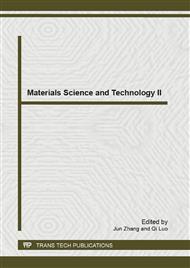[1]
L.T. Canham: Appl. Phys. Lett. Vol. 57 (1990), p.1046.
Google Scholar
[2]
D.J. Lockwood and L.Pavesi in: Silicon Photonics,Topics of Applied Physics, edited by L.Pavesi and D.J. Lockwood, (Springer-Verlag Berlin Heidelberg, 2004).
DOI: 10.1007/978-3-642-10506-7
Google Scholar
[3]
H. Ennen, J. Schneider, G. Pomrenke and A. Axmann: Appl. Phys. Lett. Vol. 43, (1983), p.943.
Google Scholar
[4]
A. Polman, G.N. Van den Hoven, J.S. Custer, J.H. Shin and R. Sema: J. Appl. Phys. Vol. 77 (1995), p.1256.
Google Scholar
[5]
M. Yoshihara, A. Sekiya, T. Morita, K. Ishii, S. Shimoto and S.Sakai: J. Phys. D:Appl. Phys. Vol. 30, (1997), p.1908.
Google Scholar
[6]
H. Amekura, A. Eckau, R. Carius and Ch. Buchal: J. Appl, Phys. Vol. 84 (1998), p.3867.
Google Scholar
[7]
J.M. Sun, W. Skorupa, T. Dekorsy, M. Helm, L. Rebohle and T. Gebel: J. Appl. Phys. Vol. 97 (2005), p.123513.
DOI: 10.1063/1.1935766
Google Scholar
[8]
M.E. Castagna, S. Coffa, M. Monaco, A. Muscara, L. Caristia, S. Lorenti and A. Messina: Mater. Sci. Engin. B Vol. 105 (2003), p.83.
DOI: 10.1016/j.mseb.2003.08.021
Google Scholar
[9]
M.J.V. Bell, L.A.O. Nunes and A.R. Zanatta: J. Appl. Phys. Vol. 86, (1999), p.338.
Google Scholar
[10]
A.R. Zanatta, C.T.M. Ribeiro and U. Jahn: Appl. Phys. Lett. Vol. 79 (2001), p.488.
Google Scholar
[11]
A.R. Zanatta, M.J.V. Bell and L.A.O. Nunes: Phys. Rev. B Vol. 59 (1999), p.10091.
Google Scholar
[12]
H. Kato, A. Masuzawa, T. Nowa, K. Soo Seol and Y. Ohki: J. Phys.: Condensed Matter Vol. 13 (2001), p.6541.
Google Scholar
[13]
B. Stannowshi, J.K. Rath and R.E.I. Schropp: J. Appl. Phys. Vol. 93 (2003), p.2618.
Google Scholar
[14]
Z. Yuan, D. Li, M. Wang, D. Gong, P. Cheng, P. Chen and D. Yang: Mater. Sci. Engin. B Vol. 146 (2008), p.126.
Google Scholar
[15]
Z. Yuan, D. Li, M. Wang, P. Chen, D. Gong, L. Wang and D. Yang: J. Appl. Phys. Vol. 100, (2006), p.083106.
Google Scholar
[16]
J.F. Ziegler, J.P. Biersack and U. Littmark: The stopping and range of ions in solids, (Pergamon Press, New York 1985).
Google Scholar
[17]
B.R. Judd: Phys. Rev. Vol. 127 (1962), p.750.
Google Scholar
[18]
G.S. Ofelt: J. Chem. Phys. Vol. 37 (1962), p.511.
Google Scholar
[19]
W.T. Carnall, P.R. Fields and K. Rajnak,: J. Chem. Phys. Vol. 49 (1968), p.4447.
Google Scholar
[20]
W.L. Warren, P.M. Lenahan and S E. Curry: Phys. Rev. Lett. Vol. 65 (1990), p.207.
Google Scholar
[21]
S.V. Deshpande, E. Gulari, S. Brown and S. Rand: J. Appl. Phys. Vol. 77 (1995), p.6534.
Google Scholar
[22]
J. Robertson and M. J. Powell: Appl. Phys. Lett. Vol. 44 (1984), p.415.
Google Scholar
[23]
W.L. Warren, J. Robertson and J. Kanichi: Appl. Phys. Lett. Vol. 63 (1993), p.2685.
Google Scholar
[24]
H. Jeong, S. Seo and J.H. Shin: Appl. Phys. Lett. Vol. 88 (2006), p.161910.
Google Scholar


